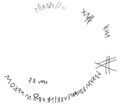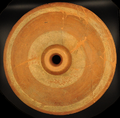VB·3.4: Difference between revisions
No edit summary |
No edit summary |
||
| (One intermediate revision by the same user not shown) | |||
| Line 1: | Line 1: | ||
{{inscription | {{inscription | ||
|reading=tu?? | |reading=tu?? | ||
|reading_lepontic=??{{c|U}}{{c|T}} | |reading_lepontic={{c|separator|separator2}}??{{c|U}}{{c|T}} | ||
|reading_variant={{c| | |reading_variant={{w|tuni}}<br>{{c||separator2}}{{c|I}}{{c|N}}{{c||U}}{{c||T}} | ||
|direction=sinistroverse | |direction=sinistroverse | ||
|letter_height_min=0 | |letter_height_min=0.5 cm | ||
| | |letter_height_max=0.8 cm | ||
| | |letter_number_min=4 | ||
|word_number=1 | |word_number=1 | ||
|line_number=1 | |line_number=1 | ||
| Line 16: | Line 16: | ||
|orientation=0 | |orientation=0 | ||
|workmanship=scratched after firing | |workmanship=scratched after firing | ||
|condition= | |condition=complete, damaged | ||
|type_inscription=unknown | |type_inscription=unknown | ||
|language= | |language=Celtic | ||
|linguistic_ascription=perhaps | |||
|meaning=unknown | |meaning=unknown | ||
|whatmough=304 | |whatmough=304 | ||
| Line 25: | Line 26: | ||
|morandi=48 B3 | |morandi=48 B3 | ||
|source_detail=Morandi 2004: 550–552 no. 48 B3 | |source_detail=Morandi 2004: 550–552 no. 48 B3 | ||
|checklevel= | |checklevel=2 | ||
|problem= | |problem=tuni weg? was sagt PID? literature | ||
|disambiguation=VB·3 | |disambiguation=VB·3 | ||
}} | }} | ||
==Commentary== | ==Commentary== | ||
First published in | First published in {{bib|Bianchetti 1895}}: 69 f. (no. 21). Examined for LexLep on 20<sup>th</sup> April 2024. | ||
Images in {{bib|Lejeune 1987}}: pl. XIIIc (photo = {{bib|Solinas 1995}}: tav. LXXIb), {{bib|Morandi 2004}}: 566, fig. 12.48 (drawing). | Images in {{bib|Lejeune 1987}}: pl. XIIIc (photo = {{bib|Solinas 1995}}: tav. LXXIb), {{bib|Morandi 2004}}: 566, fig. 12.48 (drawing). | ||
{{bib|Kretschmer 1905}}: 99, no. 21 | Inscribed a few centimetres after [[VB·3.3]], near the innermost of the white bands (length 2 cm). {{c||T}} and {{c||U}} are preserved completely on two fragments, but the two following letters are damaged by a break and lacuna, leaving only two hastae. The confidence with which Bianchetti read ''tuni'' begs the question whether another fragment has been lost since the excavation, or whether the fragment with ''tu''? was better preserved. ''tuni'' is given by all later scholars, some of whom saw the document ({{bib|Kretschmer 1905}}: 99, no. 21, {{bib|Rhŷs 1913}}: 62, no. 20 (b), {{bib|Whatmough 1933}}: 111–113, no. 304 (d), {{bib|Pisani 1964}}: 286 f., no. 124 (d), {{bib|Lejeune 1987}}: 497, {{bib|Tibiletti Bruno 1978}}: 144–146, {{bib|Tibiletti Bruno 1981}}: 162–164, no. 10, {{bib|Morandi 2004}}: 550–552 no. 48 B1 expressly on the basis of previous authors); the only one to reflect the damage is {{bib|Solinas 1995}}: 375, no. 128 2, who transliterates ''tu''[. Another point of uncertainty concerns the two dots after the last letter, which are reflected as a separator by Bianchetti and all following authors except Morandi and Solinas. While the two marks are quite clear, the look much like other spots of surface damage, though this may be due to subsequent abrasion of the areas around intentionally created dots. We include the dots in the reading, since separators are present in at least two other inscriptions on the flask. The wobbly execution of upsilon is reminiscent of that of the second letter in [[VB·3.3]]. | ||
{{w||tuni}} may be an abbreviation of a personal name or a genitive. | |||
See also {{bib|Giussani 1902}}: 55 f., '''{{bib|Piana Agostinetti 1972}}: 272, no. 12, tav. XXXI.12''', '''{{bib|Piana Agostinetti 1997–1999}} II: 57, in IV {{bib|Morandi 1999b}}: 308–312, no. 4'''. | See also {{bib|Giussani 1902}}: 55 f., '''{{bib|Piana Agostinetti 1972}}: 272, no. 12, tav. XXXI.12''', '''{{bib|Piana Agostinetti 1997–1999}} II: 57, in IV {{bib|Morandi 1999b}}: 308–312, no. 4'''. | ||
<p style="text-align:right;>[[User:Corinna Salomon|Corinna Salomon]]</p> | |||
{{bibliography}} | {{bibliography}} | ||
Revision as of 20:56, 18 June 2024
| Inscription | |
|---|---|
| Reading in transliteration: | tu?? |
| Reading in original script: | |
| Variant reading: | tuni |
|
| |
| Object: | VB·3 Ornavasso (bottle) (Inscriptions: VB·3.1, VB·3.2, VB·3.3, VB·3.4, VB·3.5) |
| Position: | shoulder, outside |
| Orientation: | 0° |
| Direction of writing: | sinistroverse |
| Script: | North Italic script (Lepontic alphabet) |
| Letter height: | 0.5–0.8 cm0.197 in <br />0.315 in <br /> |
| Number of letters: | 4 |
| Number of words: | 1 |
| Number of lines: | 1 |
| Workmanship: | scratched after firing |
| Condition: | complete, damaged |
|
| |
| Archaeological culture: | La Tène D 1 [from object] |
| Date of inscription: | end of 2nd/beginning of 1st c. BC [from object] |
|
| |
| Type: | unknown |
| Language: | perhaps Celtic |
| Meaning: | unknown |
|
| |
| Alternative sigla: | Whatmough 1933 (PID): 304 Tibiletti Bruno 1981: 10 Solinas 1995: 128 5 Morandi 2004: 48 B3 |
|
| |
| Sources: | Morandi 2004: 550–552 no. 48 B3 |
Images
Commentary
First published in Bianchetti 1895: 69 f. (no. 21). Examined for LexLep on 20th April 2024.
Images in Lejeune 1987: pl. XIIIc (photo = Solinas 1995: tav. LXXIb), Morandi 2004: 566, fig. 12.48 (drawing).
Inscribed a few centimetres after VB·3.3, near the innermost of the white bands (length 2 cm). ![]() and
and ![]() are preserved completely on two fragments, but the two following letters are damaged by a break and lacuna, leaving only two hastae. The confidence with which Bianchetti read tuni begs the question whether another fragment has been lost since the excavation, or whether the fragment with tu? was better preserved. tuni is given by all later scholars, some of whom saw the document (Kretschmer 1905: 99, no. 21, Rhŷs 1913: 62, no. 20 (b), Whatmough 1933: 111–113, no. 304 (d), Pisani 1964: 286 f., no. 124 (d), Lejeune 1987: 497, Tibiletti Bruno 1978: 144–146, Tibiletti Bruno 1981: 162–164, no. 10, Morandi 2004: 550–552 no. 48 B1 expressly on the basis of previous authors); the only one to reflect the damage is Solinas 1995: 375, no. 128 2, who transliterates tu[. Another point of uncertainty concerns the two dots after the last letter, which are reflected as a separator by Bianchetti and all following authors except Morandi and Solinas. While the two marks are quite clear, the look much like other spots of surface damage, though this may be due to subsequent abrasion of the areas around intentionally created dots. We include the dots in the reading, since separators are present in at least two other inscriptions on the flask. The wobbly execution of upsilon is reminiscent of that of the second letter in VB·3.3.
are preserved completely on two fragments, but the two following letters are damaged by a break and lacuna, leaving only two hastae. The confidence with which Bianchetti read tuni begs the question whether another fragment has been lost since the excavation, or whether the fragment with tu? was better preserved. tuni is given by all later scholars, some of whom saw the document (Kretschmer 1905: 99, no. 21, Rhŷs 1913: 62, no. 20 (b), Whatmough 1933: 111–113, no. 304 (d), Pisani 1964: 286 f., no. 124 (d), Lejeune 1987: 497, Tibiletti Bruno 1978: 144–146, Tibiletti Bruno 1981: 162–164, no. 10, Morandi 2004: 550–552 no. 48 B1 expressly on the basis of previous authors); the only one to reflect the damage is Solinas 1995: 375, no. 128 2, who transliterates tu[. Another point of uncertainty concerns the two dots after the last letter, which are reflected as a separator by Bianchetti and all following authors except Morandi and Solinas. While the two marks are quite clear, the look much like other spots of surface damage, though this may be due to subsequent abrasion of the areas around intentionally created dots. We include the dots in the reading, since separators are present in at least two other inscriptions on the flask. The wobbly execution of upsilon is reminiscent of that of the second letter in VB·3.3.
tuni may be an abbreviation of a personal name or a genitive.
See also Giussani 1902: 55 f., Piana Agostinetti 1972: 272, no. 12, tav. XXXI.12, Piana Agostinetti 1997–1999 II: 57, in IV Morandi 1999b: 308–312, no. 4.
Bibliography
| Bianchetti 1895 | Enrico Bianchetti, I sepolcreti di Ornavasso [= Atti della Società di Archeologia e Belle Arti della provincia di Torino 6], Torino: Paravia 1895. |
|---|---|
| Giussani 1902 | A[ntonio] Giussani, "L' iscrizione nord-etrusca di Tesserete e le altre iscrizioni pre-romane del nostro territorio", Rivista Archeologica della Provincia e Antica Diocesi di Como 46 (1902), 25–67. |




